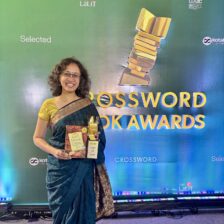Thrills and Chills – A Horror Writing Workshop with Shabnam Minwalla
December 12, 2025
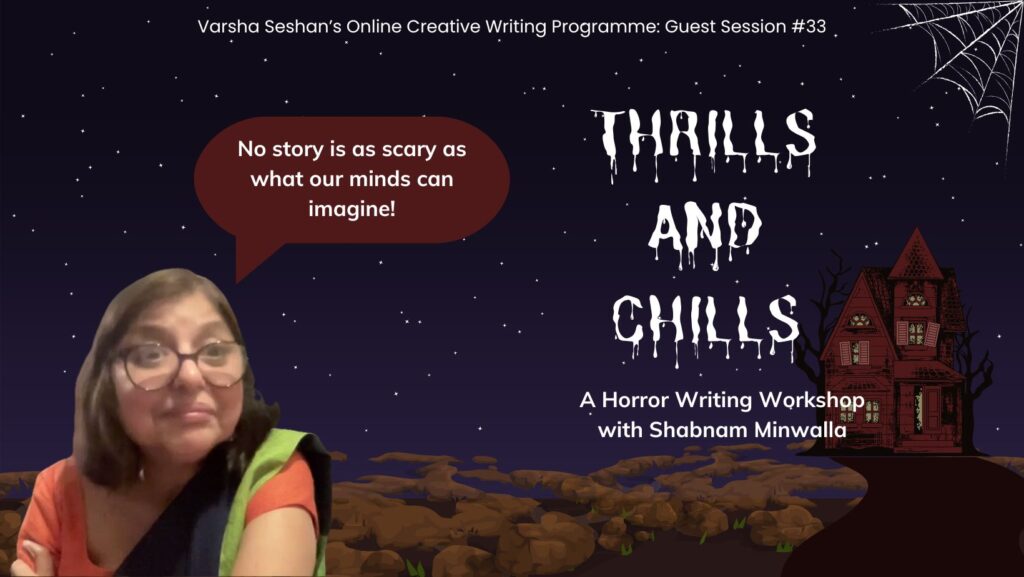
What a thrilling, chilling session we had with Shabnam Minwalla! It was interactive and fun, full of creepy examples and wonderful ideas.
Shabnam began by telling us what inspired her book Saira Zariwala Is Afraid–mysterious messages on her daughter’s phone. From there, we explored all kinds of things, from settings, to concepts for horror stories. I loved how many participants shared examples of regular places that become sinister! Playgrounds, people who are a little too sweet, mysterious lights … Even ordinary places like schools and malls have so much potential for horror!
One big takeaway for me was the idea that what we imagine is far more frightening than what is written. As a result, an unreliable narrator who makes us feel uncertain works perfectly for horror!
Beginning with a setting that has potential, moving to a “what-if” sentence, and then creating a sense of suspicion, where we wonder whom to trust–these are the makings of a great horror story!
I can’t believe that this was my thirty-third guest! We’ve explored so many genres and worked on so many different styles. I’m grateful to each guest who’s added a spark to my writing programmes. This one was the last of the season; look out for the next guest session in April 2026!
Delightfully True – A Workshop on Writing Creative Nonfiction
November 9, 2025
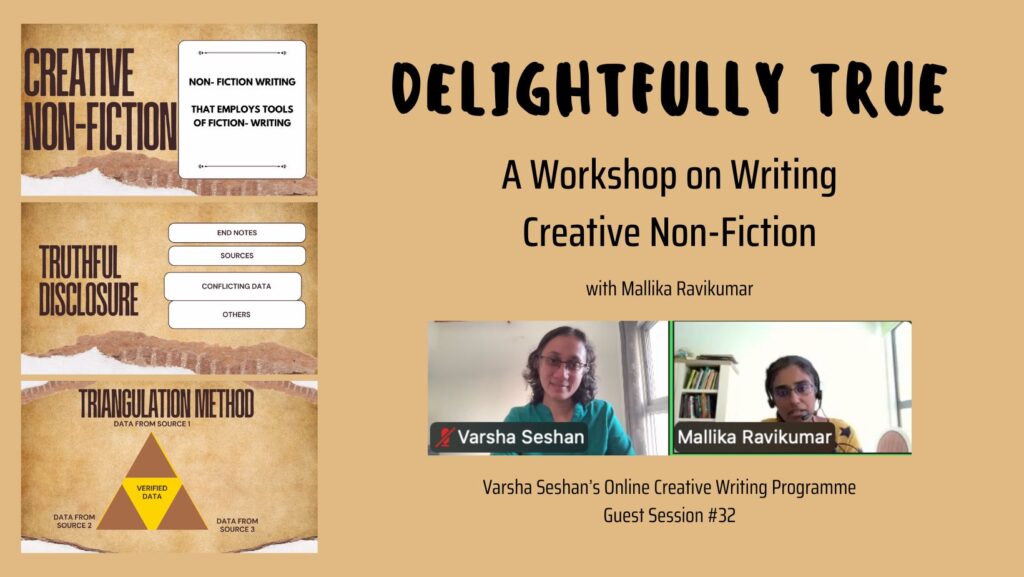
What is creative nonfiction? What makes it different from regular nonfiction?
Award-winning author Mallika Ravikumar led us through the second guest session of the season, teaching students what makes creative nonfiction engaging. From techniques of writing–like showing instead of telling–to research methodology, Mallika helped students understand how to go about writing credible creative nonfiction.
An important aspect of writing about true events is perspective. The same incidents can be viewed from multiple points of view. How do we choose a point of view? And what is our responsibility as writers once we’ve chosen a viewpoint?
At the end of the session, lots of participants who had read Mallika’s books had questions for her, which was heartwarming! She left them with an exercise that explores perspective and technique, which I hope will give them firsthand experience of how engaging creative nonfiction can be!
Manya Learns to Roar
November 7, 2025
We’re rereading Manya Learns to Roar by Shruthi Rao at my book club! We read it at the very first edition of my reading programme, when I tentatively started out in 2020, wondering if I would be able to sustain an online book club for children. All those who read it with me then are now too old to be part of the book club, so it’s time to reintroduce a book I love!
Banyan High School, is going to present a play based on Rudyard Kipling’s The Jungle Book, and Manya wants the role of Shere Khan. She knows it is the first step towards winning an Oscar, and she’s already writing her acceptance speech for that.
I loved Manya Learns to Roar because of how true it is to childhood dreams and the way each child is such a charming mixture of supreme confidence and deep vulnerability.
Before I even read the book, I was drawn to the idea of a child with a stammer determined to take part in a school play. Once I read it, I knew I had to work with it because there’s just so much you can do with a book like this!
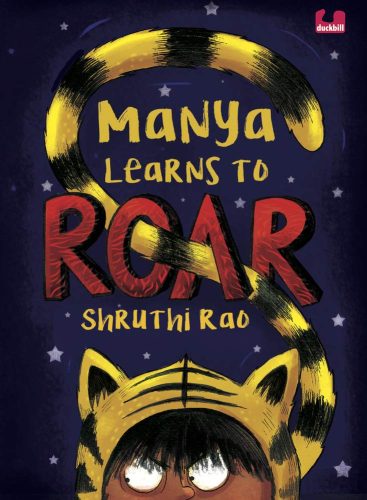
Codes
When I started reading Manya Learns to Roar, I didn’t notice that the chapter numbers were written in the special code that Manya and her best friend Ankita share. I think I was on chapter six when my eyes widened. Ooh! The chapter names are in code! And as Manya and Ankita know, the very fact that it is bound to be dismissed as random doodling makes it the perfect kind of code. Codes, puzzles and cryptograms are thrilling, and I know that the children at the reading programme will enjoy them as much as I do!
Speaking
Did you know that tongue twisters are said to be a great way to overcome a stutter? Manya Learns to Roar provides the perfect opportunity to work on speech and recitation. Reading aloud is one aspect of the programme, and tongue twisters will make a fun addition to all the speaking we do.
Drama
As a book that revolves around the production of a play, it’s ideal for my ‘come as a character‘ activity! While I hope that children will come as one of the characters from the books we read together, I don’t mind if they choose someone else altogether. The element of surprise makes everything fun!
Join my book club!
Registrations are now closed for the December 25 – January 26 edition of my book club. New batches begin every alternate month. Join my mailing list if you would like to receive email notifications about my programmes. Alternatively, follow me on social media – Facebook and Instagram – for regular updates.
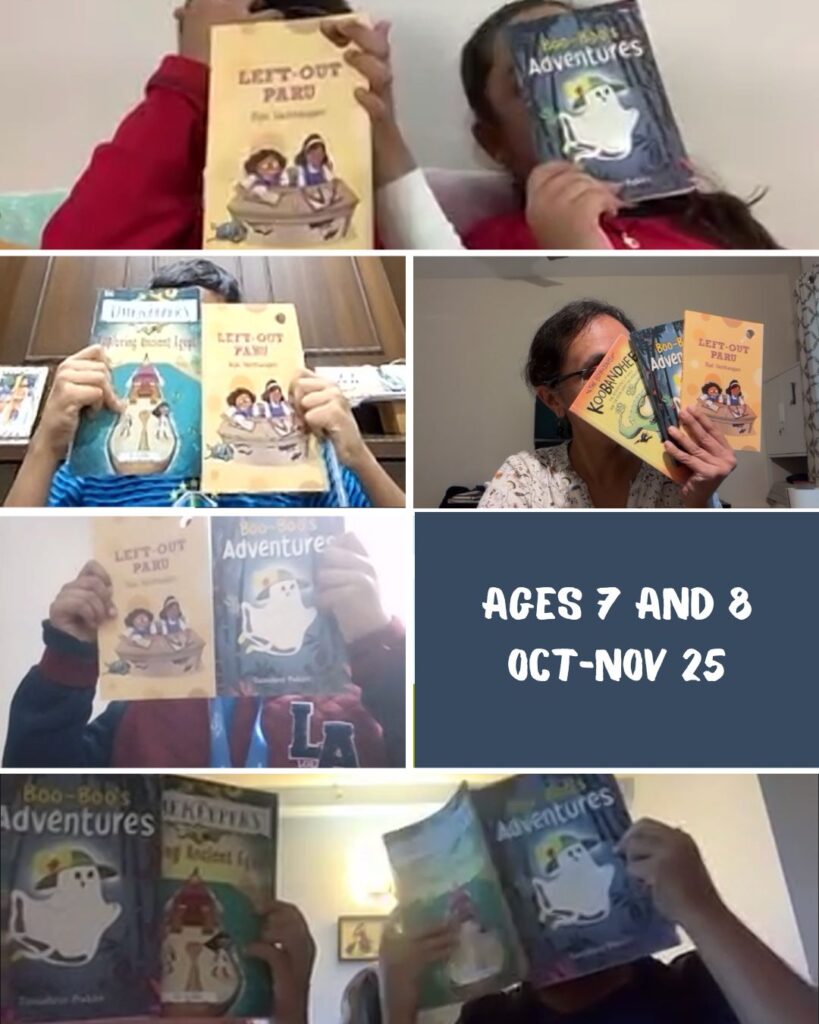
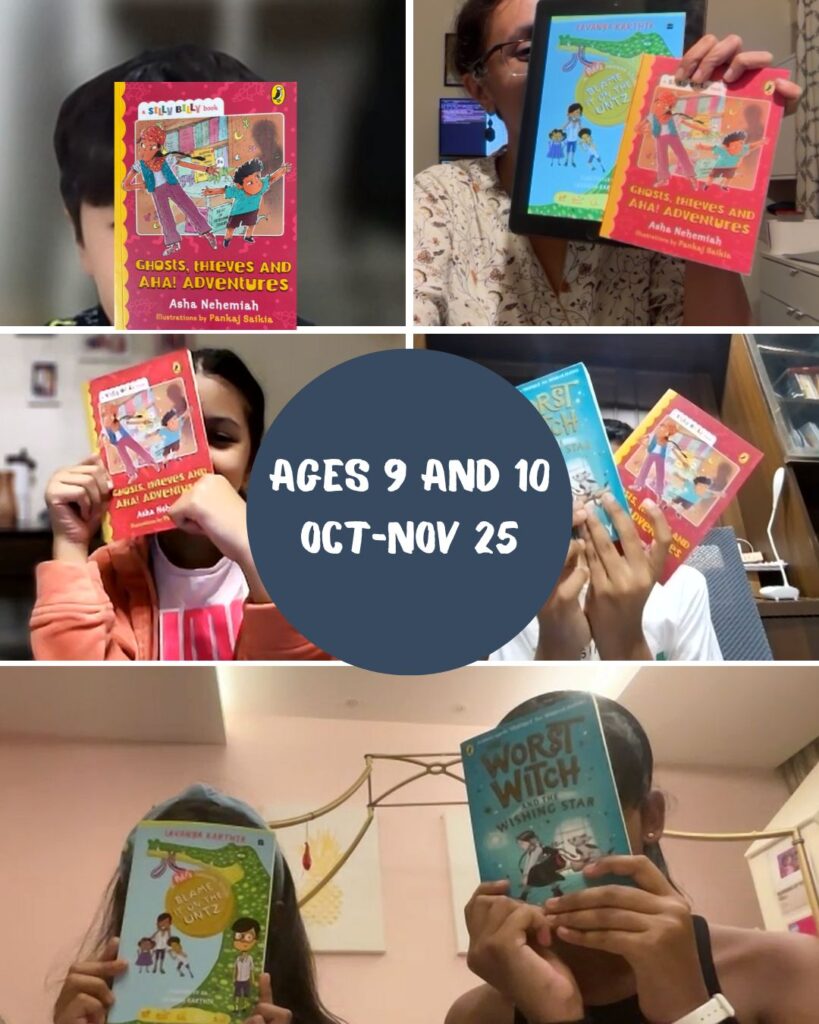
The Wall Friends Club
November 6, 2025
The Wall Friends Club won the Crossword Book Award 2025! I’m so excited to be introducing this book of mine to young readers!
In this book, Anandi, a soon-to-be 10-year-old leaves a letter in a gap in the wall for someone else to find. When Sriya finds the letter, they begin to write to each other regularly. Old-fashioned letter-writing will be fun to explore with my book clubbers!
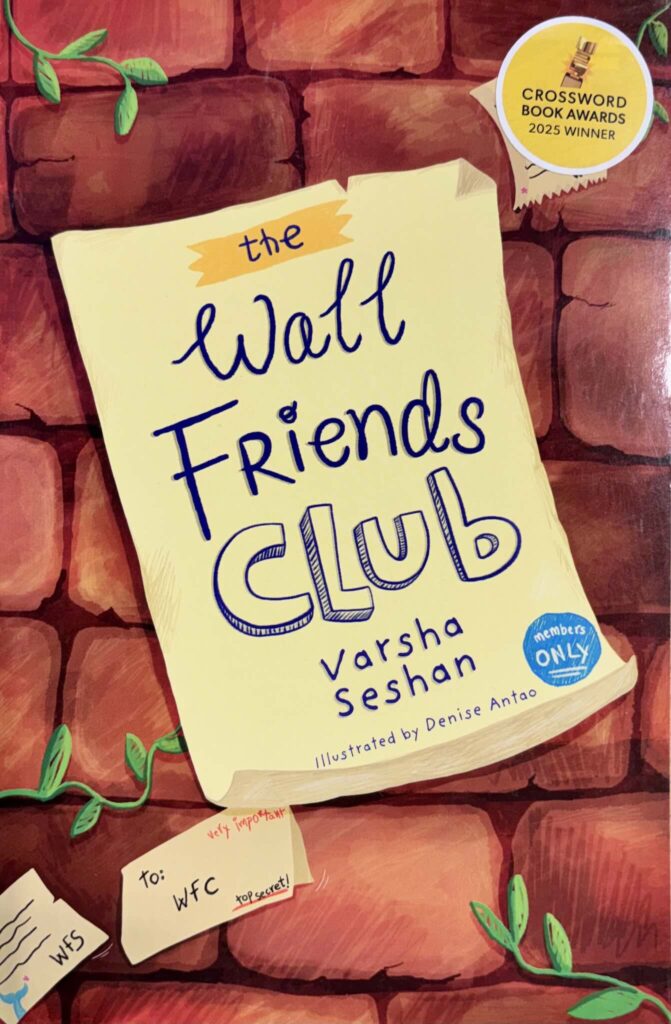
Clubs
Have you read books about clubs? What do the clubs do? If you set up a club, what would you call it? Who would be part of it? What would you do together?
Writing Letters
Anandi and Sriya are becoming the best of friends, but they have never met! What would you write to a stranger? Let’s write a letter together!
Code-Making and Code-Breaking
Sriya is a master code-maker! What about you? Can you solve a cryptogram? Write and decipher messages in code as you explore the book!
Join my book club!
Over the years, I’ve introduced several of my books to my book clubbers!
- The Clockwala’s Clues
- Dragonflies, Jigsaws and Seashells
- Dhara’s Revolution
- The Best Idea of All
- The Prophecy of Rasphora
Looking forward to reading another one with them!
Registrations are now closed for the December 25 – January 26 edition of Read, Write, Explore. New batches begin every alternate month. Join my mailing list if you would like to receive email notifications about my programmes. Alternatively, follow me on social media – Facebook and Instagram – for regular updates.


The Kingdom of Wrenly: Adventures in Flatfrost
November 5, 2025
Fantasy is almost always guaranteed to appeal to my book clubbers! And that’s why we’re reading two works of fantasy this time–The Vampire Boy and Adventures in Flatfrost. The latter is part of a well-loved series too, making it all the more exciting for my book clubbers. Just like when we read a couple of books from The Dragon Masters series, I’m sure that at least some of my book clubbers will end up reading several other books in the set!
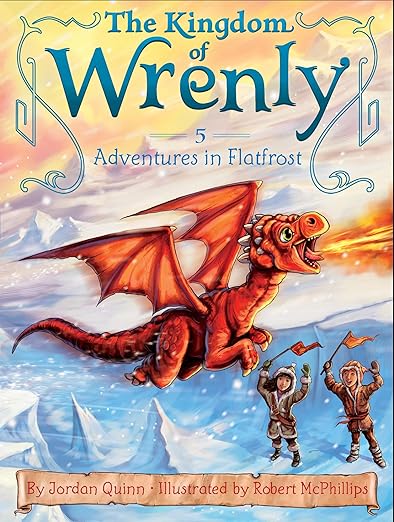
A Pet Dragon
If you had a pet dragon, how do you think you would train it? We’ll work on creating a dragon character with a human friend. How does the dragon look? Where does it live? Let’s draw a picture!
I would also love to see if we can invert the idea. What if you were a dragon’s pet? How would you need to be trained?
World Building
Several years ago, when we read Paati Goes Viral, we worked on world building with a fun activity involving beans, pencils and a map! I’m looking forward to repeating this with a new set of book clubbers.
Magical Adventures
A story needs a problem and a solution, so we will work on an elementary understanding of this idea. What is the problem in the story and how do Lucas, Carla and Ruskin find a solution? Once we have worked on this idea, we’ll come up with other problems the characters in Wrenly could face, and how they would find imaginative solutions!
Join a book club!
I love to see my regulars slowly building their own libraries! As they outgrow books and pass them on to new readers, they discover new favourites. It’s heart-warming!
Registrations are now closed for the December 25 – January 26 edition of my book club. New batches begin every alternate month. Join my mailing list if you would like to receive email notifications about my programmes. Alternatively, follow me on social media – Facebook and Instagram – for regular updates.


Frindle
November 4, 2025
We’re rereading Frindle at my book club! I read it quite a long time ago, and it’s EXACTLY my kind of book.
Nick Allen isn’t really a troublemaker. He just likes to have fun. And where’s the harm in making up a new word?
Pen. Quite a boring, mundane word. Why not call it a frindle instead?
And that’s the premise of this delightful, fun story that keeps you reading page after page. I love how the book is plotted as well as how the characters develop as the story proceeds. Finally, a book about words is perfect for a book club!
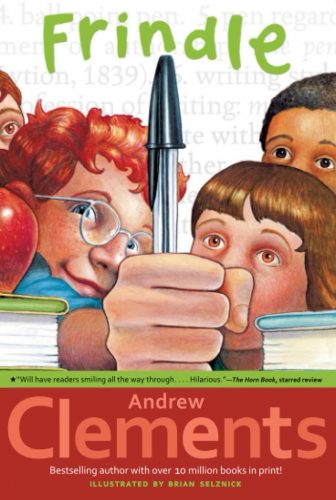
The Question
As so many children have just come back after their Diwali holidays, chapter three is perfect! Following Nick Allen’s school system, we’ll talk about our summer, do a quick vocabulary quiz, and then come to the most fun thing of all – the time-wasting question. I know that this part will make the children giggle, and I can’t wait to see what mischievous, fun ideas they come up with when we discuss what they do to postpone a lesson just a little bit!
Making Up Words
When we read Paati Goes Viral, we spoke about how words are created, and how their meaning changes. We then made up words of our own, which we promised to use right through that edition of my reading programme. I remember at least three words the children created – sclem (which was to substitute ma’am), electric (to use instead of viral) and trook (for book). It was such fun!
With Frindle, I look forward to doing something similar. We’ll create new words and see how successful we are in making them common parlance.
A Letter from Ten Years Ago
No spoilers here, but Mrs. Granger writes a letter to Nick and sends it to him ten years later. He knows it’s the same letter because he wrote his name on the envelope. The letter itself turns out to be the most brilliant surprise ever.
We’re going to work with this idea in two phases. Phase 1 is where the children will make a little time capsule for themselves. Time capsules get lost, though. So, I’m also going to ask them to write notes to one another, which they will send to me privately in the chat box. Ten years later, if I can get in touch with them again, I will send them their letters. They’ll be adults by then!
From the last time I read this book, I have two letters I’ve promised to send in 2032!
Join my book club!
I love Andrew Clements’s books, and I’ve read so many of them!
Here are a few:


The Great Indian Safari
November 3, 2025
I’ve read barely any nonfiction with my book club. Historical fiction, yes, but nonfiction? I can remember having read only Sita’s Chitwan. The theme of The Great Indian Safari by Arefa Tehsin is similar–wildlife. It’s a theme close to my heart, and I find myself using every opportunity I can to introduce books about it to children.
Engaging in its format and full of possibility in terms of what I can do with it at a book club, The Great Indian Safari is a work of creative nonfiction told from the point of view of Charred the Bard, a jungle crow. I look forward to soaring through the forests of India with him!
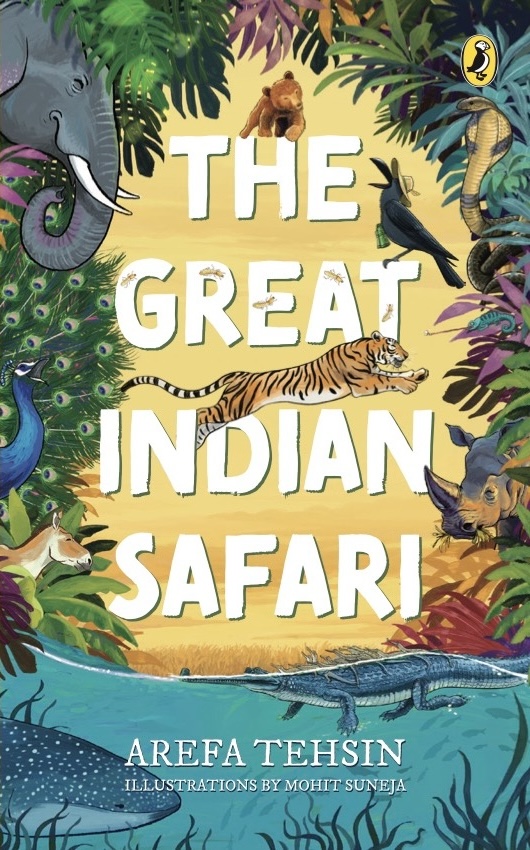
Wildlife
How many of my book clubbers have been on a safari? What rules do we follow on safaris and why? During one of our sessions, each of my book clubbers will present something about any animal found in the jungles of India. As an additional challenge, I will ask them not to choose one of those mentioned in the book!
Poetry
Charred the Bard has poems for us right through the book! This is the perfect prompt for us to work on rhyming words. We’ll do a timed activity, jotting down as many rhyming words as we can for a set of words I give the children. Perhaps we could even write a poem!
Spotting Animals
In the forest, we search for animals with our eyes peeled. For me, being on high alert is thrilling, for anything could be lurking in the bushes. While I can’t take my book clubbers to the jungle, we will do a word search instead, looking for animals in a maze of other letters!
Join a book club!
Parents and teachers often ask me how to get children to read. While there’s no foolproof method, here are three suggestions I always give them:
- catch them young
- read a range of books (and that’s why I’m introducing nonfiction again)
- make reading fun
I know I’m biased, but a book club is a great way to bring these three together. But equally, a book club is for children who already enjoy reading. Reading can be isolating, but a book club brings the excitement back with all the activities we do and conversations we have.
Registrations are now closed for the December 25 – January 26 edition of my book club. New batches begin every alternate month. Join my mailing list if you would like to receive email notifications about my programmes. Alternatively, follow me on social media – Facebook and Instagram – for regular updates.


The Great Sneak-Out
November 2, 2025
The Great Sneak-Out is such a fun book that I knew I wanted to introduce it to my book club the moment I read it! Humour, silliness and sweetness come together to make this a perfect read for the early middle-grade reader.
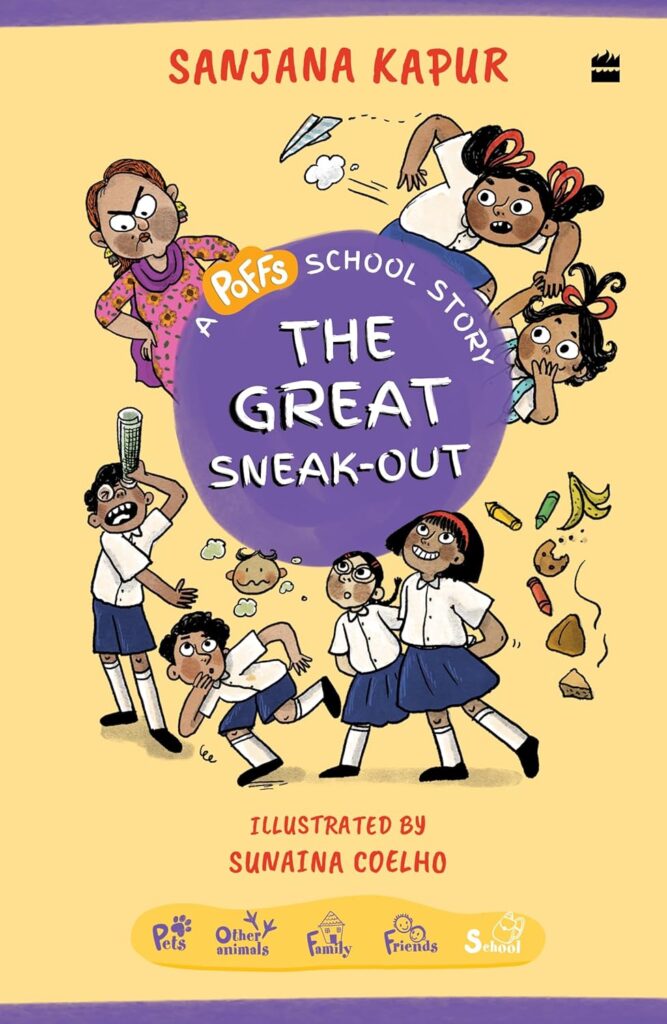
Siblings
As this is the first book we will be reading at Read, Write, Explore in December, we’ll talk about siblings, both real and fictional! Do you have a sibling? We’ll have a freewheeling conversation, but we’ll also work on similes, comparing siblings to different things in nature, an activity I’ve done before and enjoy. This will connect well to our next activity!
Figures of Speech
To say Ampoorna Ma’am was angry would have been like calling the Taj Mahal a hut.
What figure of speech is this? How can we bring humour into our writing by using comparisons? Let’s find out!
Chapter Titles
Creative writing is an essential part of Read, Write, Explore, and as we read The Great Sneak-Out, we’re going to use the chapter titles as our inspiration. ‘My Cranky Sister Can Bite’. ‘I Commit a School Crime’. What new ideas can these titles spark?
Join a book club!
Read, Write, Explore is an online reading and writing programme that combines the joy of a book club with an introduction to creative writing. I choose books that are lighthearted and easy to read, and based on these books, we do a variety of activities, including listening, critical thinking and craft. One class every two weeks is devoted to creative writing.
Registrations are now closed for the December 25 – January 26 edition of Read, Write, Explore. New batches begin every alternate month. Join my mailing list if you would like to receive email notifications about my programmes. Alternatively, follow me on social media – Facebook and Instagram – for regular updates.


The Vampire Boy
November 1, 2025
The Vampire Boy by Sharanya Deepak is another delightful hOle book – quirky and unique. We’ll be rereading it at my book club in December 2025!
The government has decided that all children – including young vampires – must go to school. What is Kristofer to do? He knows he will be shunned, but off he goes, only to meet with curiosity and bullying. In a way that is perfect for this age-group, humour underlines everything that happens to Kristofer. Soon, he makes friends with not just Bo, but also Bran, the class bully. Together, they go to school, they go on a camp, and they even catch a chicken thief!
I’m waiting to reread it with my book clubbers. Here’s what I plan to do with it.
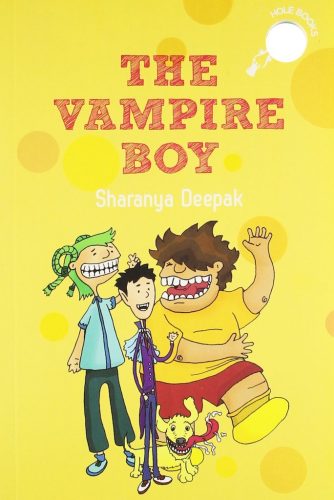
Book Discussion
Kristofer is a vampire who hates blood!
As this is the first book we will be reading together, a good way to begin is with a discussion on what makes us similar to and different from our friends and family. For example, perhaps all your friends love Geronimo Stilton and you do too. On the other hand, perhaps all your friends love cricket and you hate it. Let’s get to know one another!
Number Games
Kristofer loves numbers. He counts the stars in the sky. He counts blades of grass. He counts the number of grey hairs in Mr Gazillion’s head.
One of the reasons I choose a hOle book for each edition of my book club is that the entire set is perfect in terms of length. We have the time to read, share opinions and play games that link reading to other ideas and subjects. With The Vampire Boy, I look forward to playing number games with the children. From multiplication Bingo to counting games, there’s so much we can do with numbers!
The Five Senses
Bran and Bo are so noisy that no creatures in the forest come close to them. Yet, the great banyan tree is like magic, its leaves lit with fireflies.
This leads us to a lovely imaginative activity. Listening to a little music, the children will imagine what they can see, smell, hear, taste and feel in the forest. I’m intrigued to know what their responses will be!
Join a book club!
Registrations are now closed for the December 25 – January 26 edition of my book club. New batches begin every alternate month. Join my mailing list if you would like to receive email notifications about my programmes. Alternatively, follow me on social media – Facebook and Instagram – for regular updates.


Draw It In Style with Lavanya Karthik
October 26, 2025
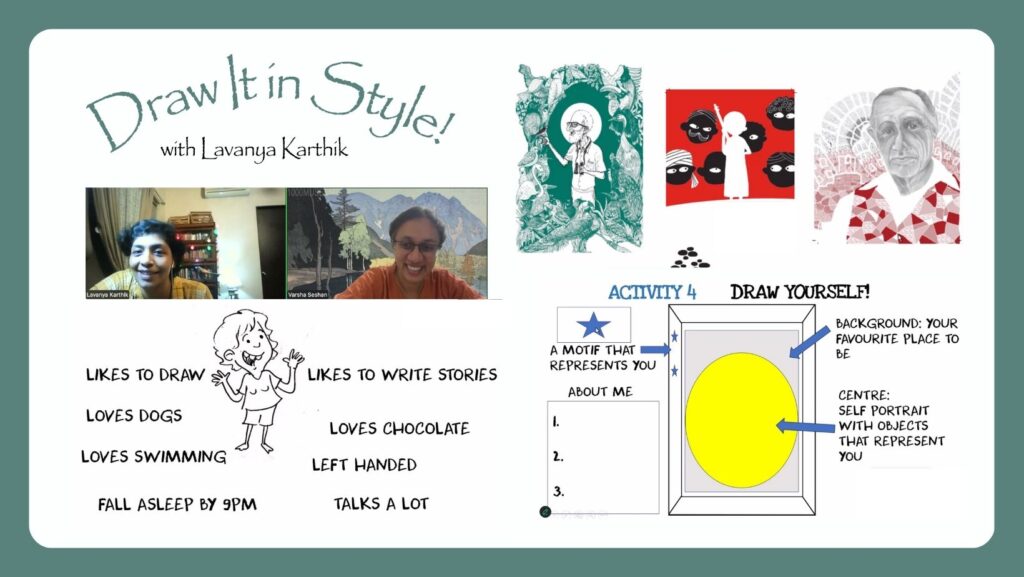
We had nearly twenty participants during the first guest session of the season, an illustration workshop with Lavanya Karthik!
Focusing particularly on her Dreamers series, Lavanya talked about her creative process, and how she chose various art styles for different books. The idea of the session was to get participants to work towards creating a self-portrait. To do this, she introduced three styles that she researched and used in her books–miniature Mughal art, which she brought into The Boy Who Loved Birds, Bhil art, which features in The Girl Who Loved to Sing, and mosaic art, which you can find in The Boy Who Built a Secret Garden.
Step by step, she led the participants towards the final activity, asking them to list personality traits, choose a symbol or motif that represents them, and work on an elaborate frame, drawing from miniature paintings. We didn’t have much time to draw, but I enjoyed the symbols the children chose–from rollerblades to a treble clef!
And the joy of online workshops? We had participants from five countries joining in! It’s such a treat to see children coming together like this!
Boo-Boo’s Adventures
September 7, 2025
We’ve read Boo-Boo Investigates and Boo-Boo the Eco-Warrior; we’re now all set to read Boo-Boo’s Adventures! My book clubbers particularly enjoy the Boo-Boo series because the chapters are like little standalone stories, which are fun and engaging. A friendly ghost and a kind human child make a charming pair!
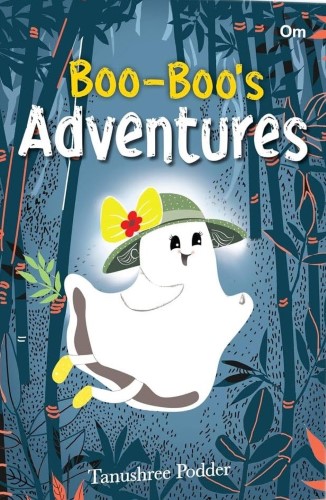
Good Deeds
GGPa announces an award for the one who does the most good deeds, and this sets the little ghost Boo-Boo off on a series of adventures. It’s a good time to talk about good deeds we can do! For one, I will ask the children what they feel they can do. Then, in the following class, I will ask each of them to tell me what good deeds they did!
Word Games
Word search puzzles, unscrambling words, and a spelling bee are a great way to revisit words we come across when we read. They’re also a fun way to acquire new vocabulary!
Create a Ghost
If you had a ghostly friend, where would they live? What would their name be, and what do you think you could do together? In what way do you think a ghostly friend would be different from a human friend?
Join a programme!
Registrations are now closed for the October-November 2025 edition of my book club. New batches begin every alternate month. Join my mailing list if you would like to receive email notifications about my programmes. Alternatively, follow me on social media – Facebook and Instagram – for regular updates.
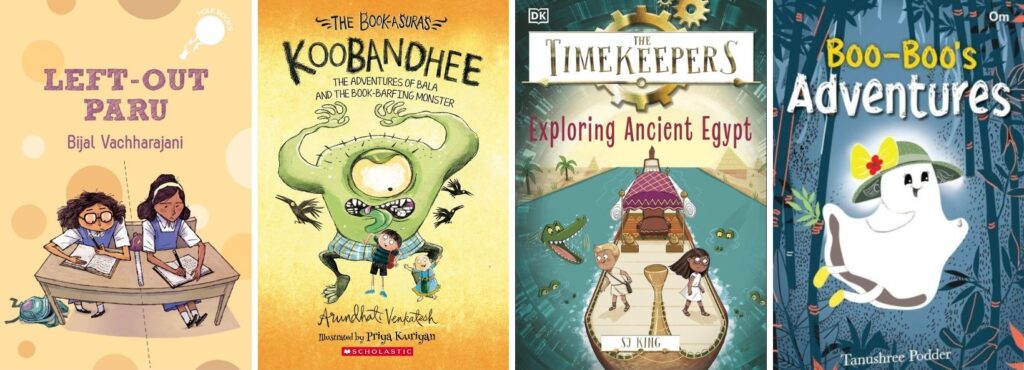
Blame It on the Untz
September 6, 2025
Blame It on the Untz by Lavanya Karthik is such a fun book! From the crocodile of group work to music making and competition, there’s so much we can do with this book at my book club! Once more, it’s part of a series–POFFS. I don’t yet know whether I will read the others in the series with my book clubbers, but I’m happy to introduce the series to them. They can decide whether they’d like to read the other books in the set!
Meanwhile, here’s what we will do as we read.
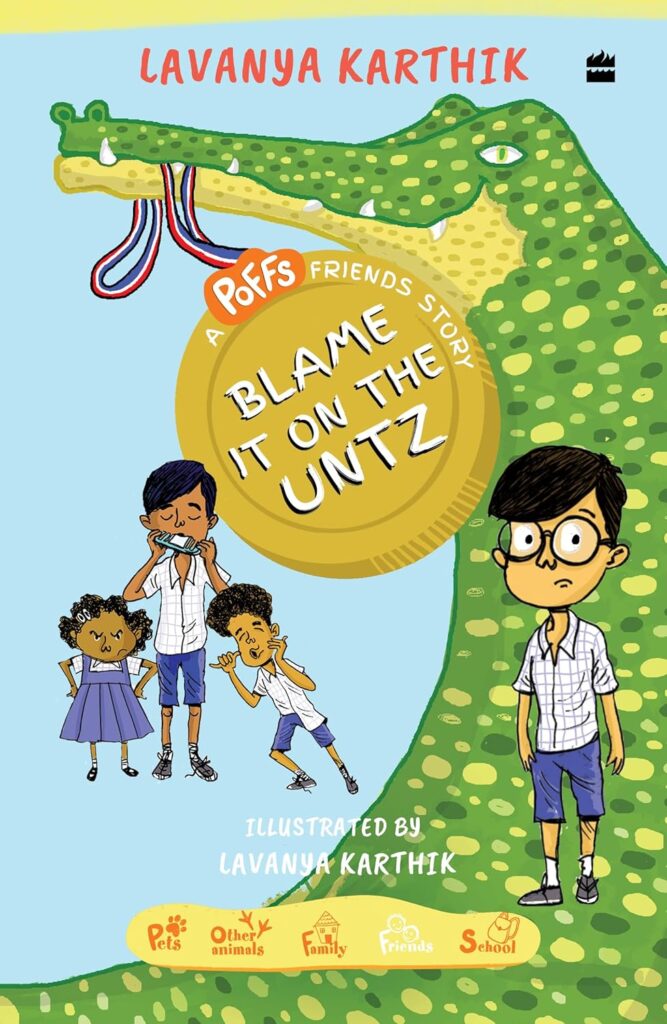
Beatboxing
I wonder: do the children at my book club know how to beat box? I’ve never asked! But Faizal in the story is a beatboxer, and perhaps we can give it a shot too. Just by chance I came across a fun beatboxing activity recently, and I can’t wait to try it out!
The Crocodile of Group Work
For Adi, the protagonist of Blame It on the Untz, group work is like a crocodile. In groups, my book clubbers will make different comparisons. What is group work like for them and why? I’m sure this will be a hilarious, imaginative activity!
Songwriting
We’ve never worked with songwriting before, and I look forward to the challenge! While we won’t look at setting it to music, we will explore how we can work on lyrics, creating both a chorus and a couple of verses.
Join a programme!
Read, Write, Explore is designed for children who want a taste of creative writing but are not necessarily ready to do all the work that an intensive writing programme demands.
Registrations are now closed for the October-November 2025 edition of my book club. New batches begin every alternate month. Join my mailing list if you would like to receive email notifications about my programmes. Alternatively, follow me on social media – Facebook and Instagram – for regular updates.
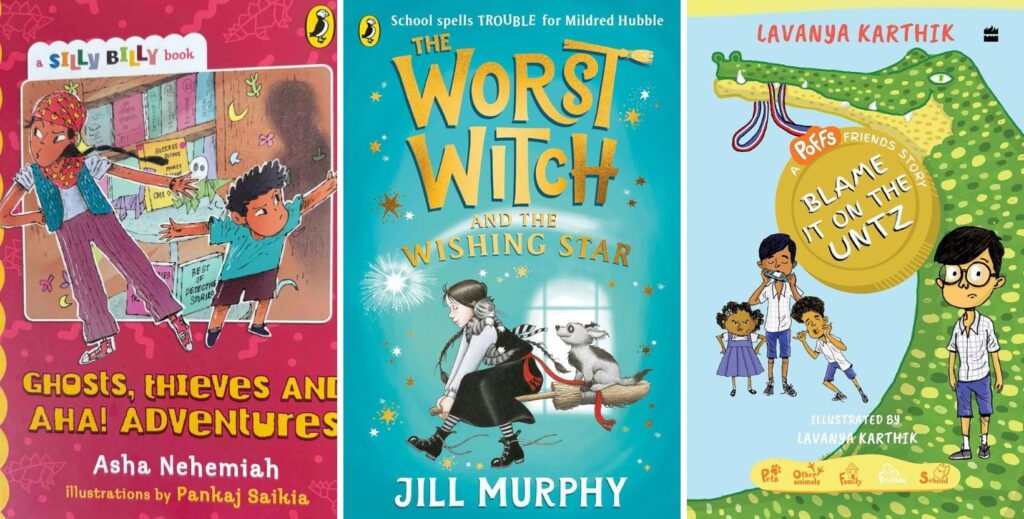
The Timekeepers: Exploring Ancient Egypt
September 5, 2025
Time travel, adventures in history, and a gang of kids set to defeat a villain come together in The Timekeepers: Exploring Ancient Egypt. At the October-November 2025 edition of my book club for ages seven and eight, I’m excited to be introducing yet another fun series of books to children. Ancient Egypt, with its mummies, pyramids, tombs and mythology, continues to fascinate children and adults. What better way to explore this ancient civilisation than through an adventure story that brings fact and fiction together?

Time Travel
If you could travel through time, how do you think you would do it? Would you need a machine? Special watches like the Timekeepers? Or something else, altogether different? As we read, I will ask the children to imagine a time machine and draw a picture. We’ll also discuss where we would like to time travel to and why!
Ancient Egypt
So many aspects of ancient Egypt are already familiar to most children! We’ll do a small word search puzzle exploring words we might be familiar with and learning a few more.
Quizzes and Timelines
The Timekeepers: Exploring Ancient Egypt includes a nonfiction section with quizzes, a timeline and a glossary. Additionally, there are links drawn between the past and the present, encouraging us to discuss what we think would be different from the ancient past and what would be similar.
Join a programme
Registrations are now closed for the October-November 2025 edition of my book club. New batches begin every alternate month. Join my mailing list if you would like to receive email notifications about my programmes. Alternatively, follow me on social media – Facebook and Instagram – for regular updates.

The Worst Witch and the Wishing Star
September 4, 2025
We read Jill Murphy’s The Worst Witch to the Rescue last year; I’m excited to read another book from the series. The Worst Witch and the Wishing Star brings together so many things children love that I’m sure we’ll enjoy it. For one, most of my book clubbers love reading about magic. Added to that, when we have wishes that come true, school rivalry, and all the hilarity that comes with a clumsy protagonist, we have the makings of a thoroughly enjoyable read!
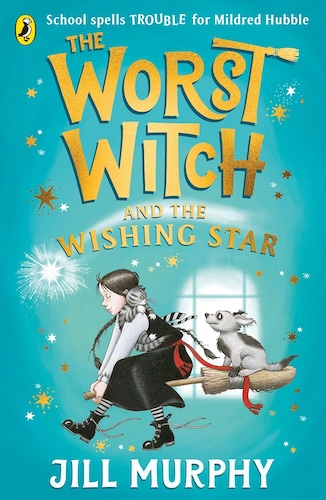
Wishes
What would you wish on? A star? A birthday cake? An eyelash? I’d love to know. Taking this further, if you could wish for anything in the world, what would you wish for?
Similarly, if you could make anyone else’s wish come true, which wish would you choose and why?
Magical Games
Stories come alive to us and linger in our imaginations because of the characters the authors painstakingly bring to life. A game I love playing is one where children name magical creatures in turn. It’s a fun game, which delves into our magical knowledge and all the fantastical creatures we’ve encountered on our reading journeys.
Fan Fiction
I taught fan fiction for the first time a few months ago, and it was such fun! Once we’ve finished reading The Worst Witch and the Wishing Star, we’ll write a story about the same characters. What other problems could they face and how would they solve them?
Join a programme!
Read, Write, Explore is designed for children who want a taste of creative writing but are not necessarily ready to do all the work that an intensive writing programme demands.
Registrations are now closed for the October-November 2025 edition of my book club. New batches begin every alternate month. Join my mailing list if you would like to receive email notifications about my programmes. Alternatively, follow me on social media – Facebook and Instagram – for regular updates.

Koobandhee
September 3, 2025
Koobandhee is such a fun book! We’ve read Bookasura twice; now we’re rereading Koobandhee too!
Bala is excited about meeting Bookasura again, but when he goes near the well at Navaneeth Uncle’s farm, he discovers another monster there, a monster that’s even scarier than Bookasura! Worst of all, Koobandhee seems like an asura who is out to destroy all Bala’s precious library books, and the librarian Mrs Shashee is not going to be happy …
A hilarious book about books, Koobandhee is perfect for my book club!
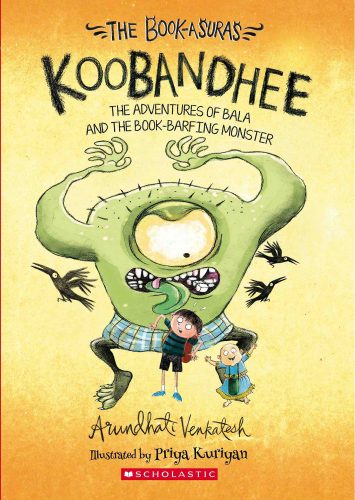
Insults
I’ve always loved imaginative insults. Of course, Shakespeare is the first to come to mind in this context, but Koobandhee has its share of wonderful ones too. Creepy cockroach! Poisonous predator! Foul flea!
We’ll do a blind activity on insults, where we make two separate lists – of adjectives and of insects. We’ll put them together at random to get hilarious results!
Monsters
Monsters are always fun. At my reading programme, we’ve been monster-hunting, discussed funny monsters, and more. This time, we’ll create a monster of our own. Quickly shifting from one group to another (children love breakout rooms!), we will invent a monster, complete with a name, physical description and personality.
Book Scavenger Hunt
We had such fun with our book scavenger hunt when we read Bookasura that I’ve been waiting for a chance to repeat the activity! In a conversation with Koobandhee towards the end of the book, a terrified Bala answers all the asura’s questions with titles of books. We’ll go through the same list in class and I’ll ask the children to run and bring books of their own. I’m waiting to see what book titles the children come up with!
Join a programme
We’ve read so many of Arundhati Venkatesh’s books at my book clubs!
- Bookasura
- Petu Pumpkin: Tiffin Thief
- Petu Pumpkin: Cheater Peter
- Petu Pumpkin: Tooth Troubles
- Petu Pumpkin: Freedom Fighter
Registrations are now closed for the October-November 2025 edition of my book club. New batches begin every alternate month. Join my mailing list if you would like to receive email notifications about my programmes. Alternatively, follow me on social media – Facebook and Instagram – for regular updates.

Ghosts, Thieves and Aha! Adventures
September 2, 2025
We’ll begin with another Silly Billy book next month! I hope there will be many more of these because it is a delightful series for young readers. With its full colour illustrations and its wacky, agenda-free stories, the series is a treat for early middle grade readers. We’ve read Jumble Sale and Agassi and the Great Cycle Race. Let’s read the third and (for now) last one in the series–Ghosts, Thieves and Aha! Adventures by Asha Nehemiah and Pankaj Saikia.
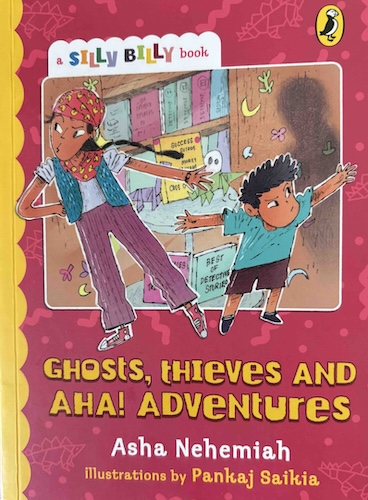
Book Scavenger Hunt
A book scavenger hunt is one of the most popular activities at my book club. How can I not do one for a book set in a bookstore? Take a look at a couple of examples of book scavenger hunts we’ve done in the past. I’m looking forward to doing another one!

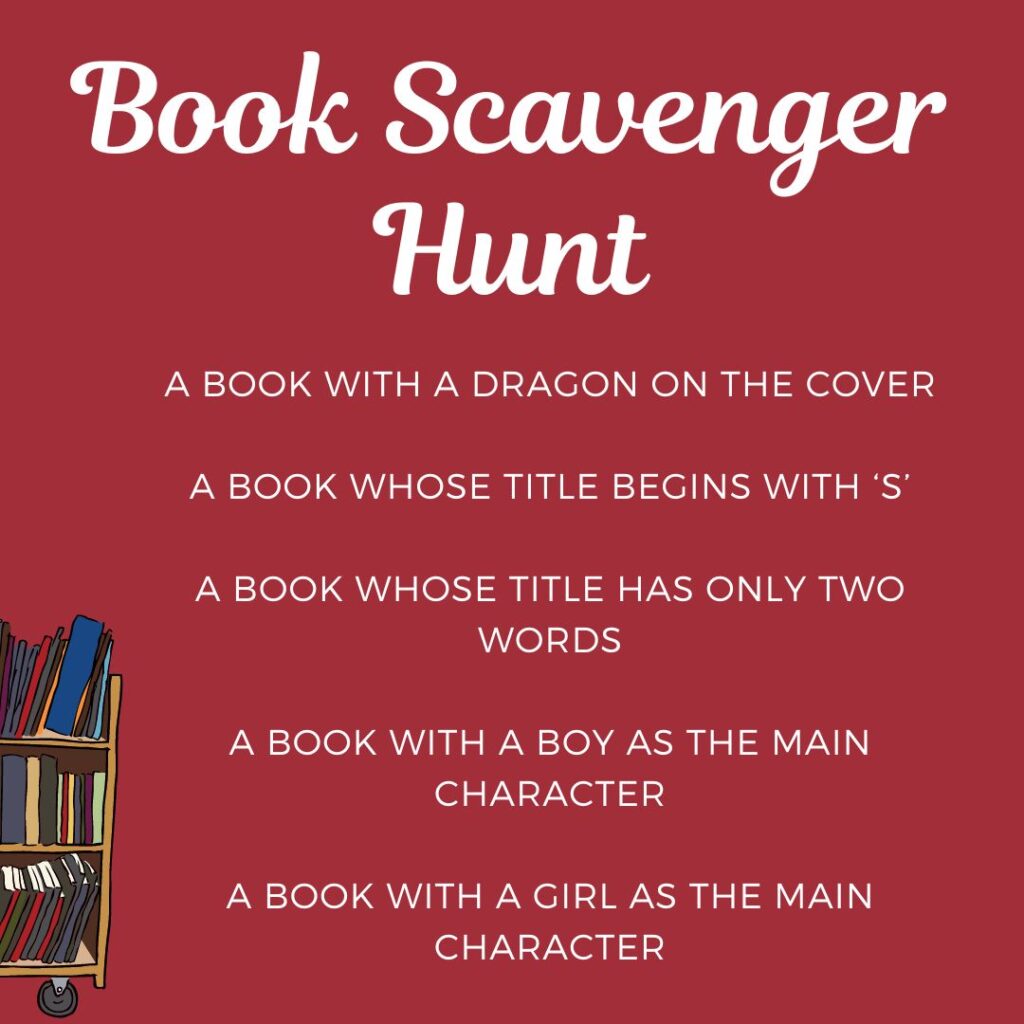
Origami
Many children at my writing programmes can do origami of all kinds. Following Ashish, the protagonist of the story, we’ll try to learn from one another, making all kinds of little origami creatures!
Bookstore Story
Every book lover loves stories set in a bookstore, so we’ll write one of our own! What kind of story could play out in a bookstore? How can we make the setting come alive to our readers?
Read, Write, Explore devotes one class every two weeks to creative writing. As we read Ghosts, Thieves and Aha! Adventures, we’ll focus on setting and genre.
Join a programme!
Read, Write, Explore is designed for children who want a taste of creative writing but are not necessarily ready to do all the work that an intensive writing programme demands.
Registrations are now closed for the October-November 2025 edition of my book club. New batches begin every alternate month. Join my mailing list if you would like to receive email notifications about my programmes. Alternatively, follow me on social media – Facebook and Instagram – for regular updates.

Left-Out Paru
September 1, 2025
A brand-new hOle book for a brand-new edition of my book club! Left-Out Paru is a book that struck a chord with me because even though I’m not left-handed, I’ve thought about lots of things designed for right-handed people. Scissors. Cameras. Desks. Here’s what we’ll do as we read this book by Bijal Vachharajani and Rajiv Eipe (two left-handed creators) at my book club next month!
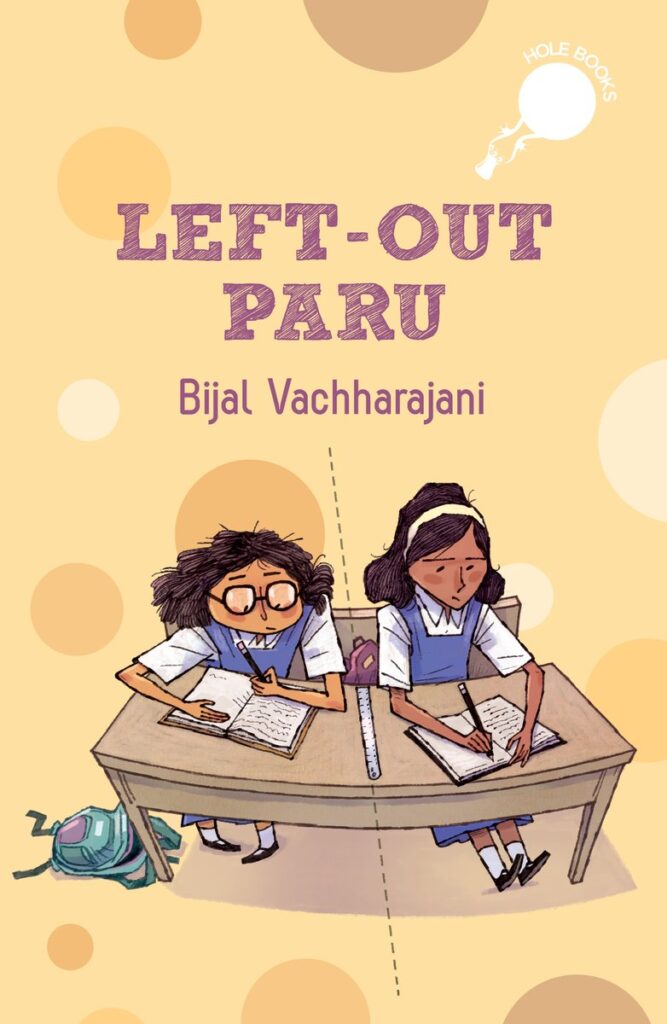
Being Left-Handed
What words and phrases do we know that favour right-handed people? We’ll do a vocabulary quiz to find out! Some words come from languages other than English; it’ll be fun to explore a range of languages, including our mother tongues!
Using Our Non-Dominant Hand
A lot of left-handers can do a surprising number of things with their right hands! Let’s see how quickly we can write, draw and cut with our non-dominant hand!
Lists
Just like Paru in the story, I love lists! As we read, we’ll use her list titles as prompts to write lists of our own–things we can’t bear, things we’re constantly told, famous lefties … I’m sure this will be entertaining!
Join a book club!
Left-Out Paru is the twenty-third hOle book we’re be reading at my book club! I love this series; it’s perfect for children moving from picture books to chapter books. The friendly font, the large illustrations, and of course, the hole in the corner make this series a treat!
Registrations are now closed for the October-November 2025 edition of my book club. New batches begin every alternate month. Join my mailing list if you would like to receive email notifications about my programmes. Alternatively, follow me on social media – Facebook and Instagram – for regular updates.

Friends Behind Walls
July 7, 2025
Inu and Putti are not allowed to play with each other. But what can they possibly do when everyone else in Shanti Park seems to have been born at the age of 30? They have no one to play with except each other!
Soon they discover that they actually like each other and want to be friends, so they need an answer to the Most Important Question: why are their families fighting?
They go to one person after another, searching for answers (or answers-shanswers, as Putti’s father would say). Mr Om Namaha, Dr Solanki and the Tekdichi Mhatari – who can answer their question?
Friends Behind Walls is such a gorgeous book that I simply had to include it in my reading programme! Here’s some of what we will do.
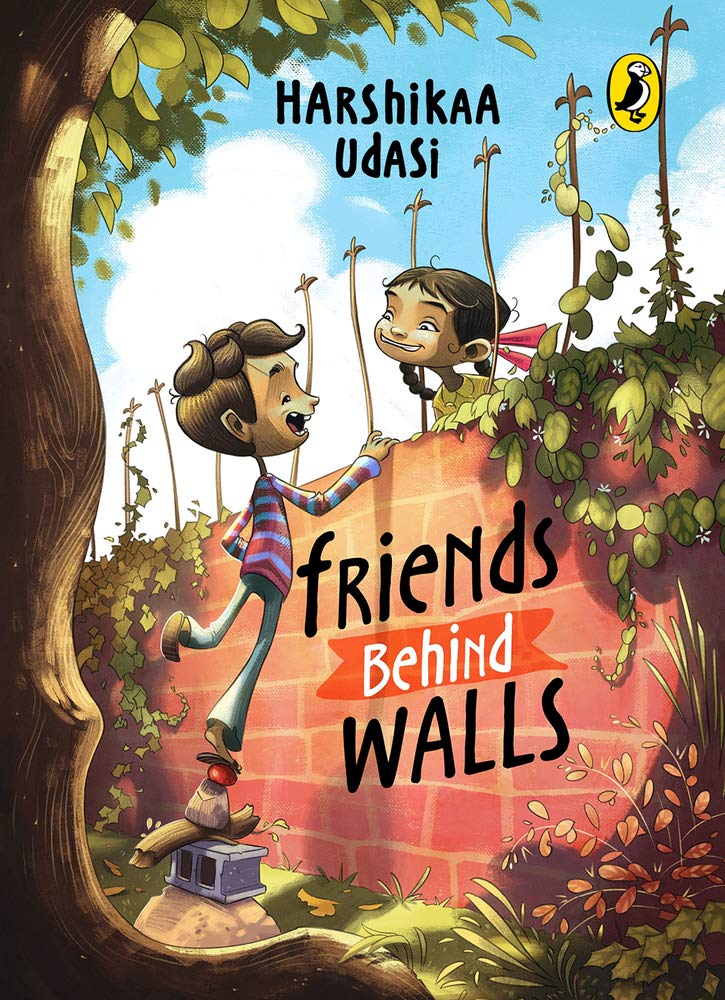
Word Games
Putti loves words and so do I. He breaks words up and comments on how nonsensical they are. Legend = lej+end, but it has nothing to do with the end of a ledge. Cacophony = cac+o+funny, but it doesn’t have anything to do with a joke.
Now imagine the possibilities of working on words with children. I’m also thinking about the multilingual games I could use and the ways in which we can play with songs!
Imagination
I LOVE the illustrations in Friends Behind Walls, and pictures make for great conversation starters. The cover itself is a good place to begin because it invites children to think about what the story could possible be about. Within the book, I love the rickshaw ride, the car ride and Tekdichi Mhatari doing a little jig. To be honest, I love them all, but these stayed with me. Working on character sketches and caricatures is going to be such fun!
Book Discussion
What do you do after a fight? What about adults? Do you think they do the same thing? What makes you angry and what do you say when you are angry?
We can talk about so many things when we read a book like Friends Behind Walls!
Join a book club!
We read Friends Behind Walls for the first time in March 2021, over four years ago! It was a favourite with my book clubbers then, and I’m waiting to read it with a fresh group of seven- and eight-year-olds!
However, registrations are now closed for the August-September 2025 edition of my book club. New batches begin every alternate month. Join my mailing list if you would like to receive email notifications about my programmes. Alternatively, follow me on social media – Facebook and Instagram – for regular updates.
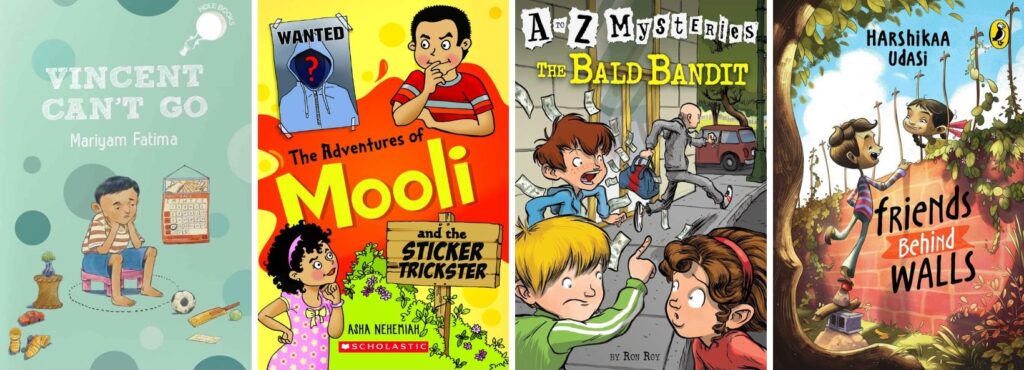
Agalya in the Spotlight
July 6, 2025
I read Agalya in the Spotlight a couple of months ago, and I knew I would introduce it to my book club very soon. It’s a light, easy read, one that I’m sure my book clubbers will enjoy. I’ve read Misfit Madhu with two batches of Read, Write, Explore, and reading a book by an author we’re familiar with is always fun!
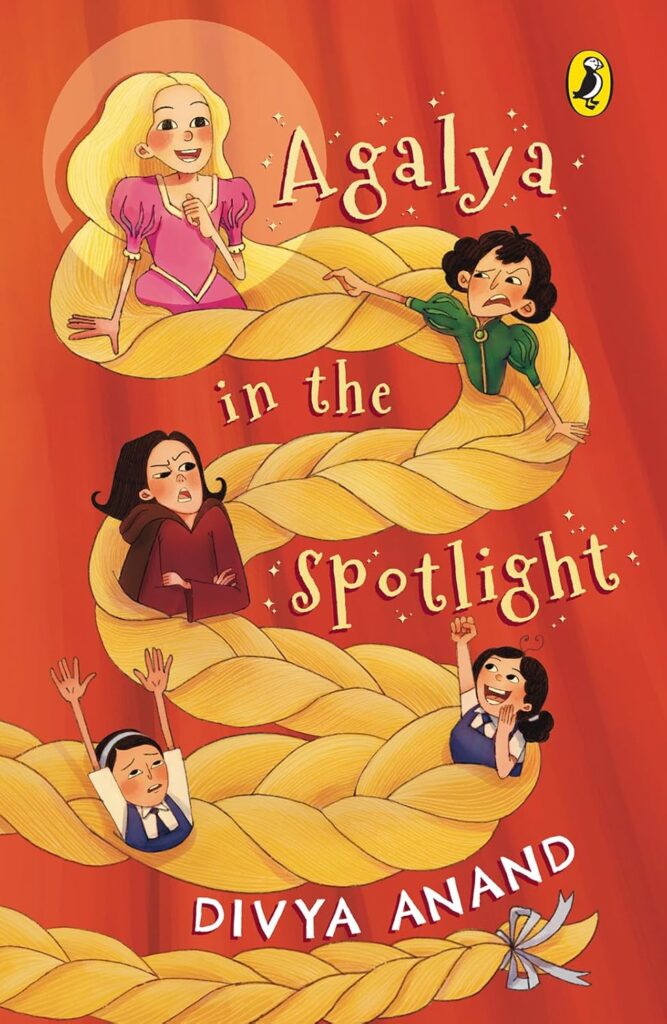
Fairy Tales
Rapunzel is a well-known fairytale, one that children are familiar with also because of the movie Tangled. At my book club, we’ll try to do a group activity in which characters from one familiar world meet characters from another. Where would they meet and what would they talk about? Exploring this promises to be fun!
Performing
A book club is never about just reading. I like to link the stories we read to all kinds of activities. Since Agalya in the Spotlight is all about drama, I will ask the children at my book club to perform in class! They can perform anything at all–they could present a poem, play an instrument, sing a song, anything at all!
Write a Play
How do we write a play? What are stage directions, and what is dialogue?
Once we’ve read Agalya in the Spotlight, I will introduce the children to playwriting, and we will try to write a short play of our own.
Join a programme!
Registrations are now closed for the August-September 2025 edition of Read, Write, Explore. New batches begin every alternate month. Join my mailing list if you would like to receive email notifications about my programmes. Alternatively, follow me on social media – Facebook and Instagram – for regular updates.
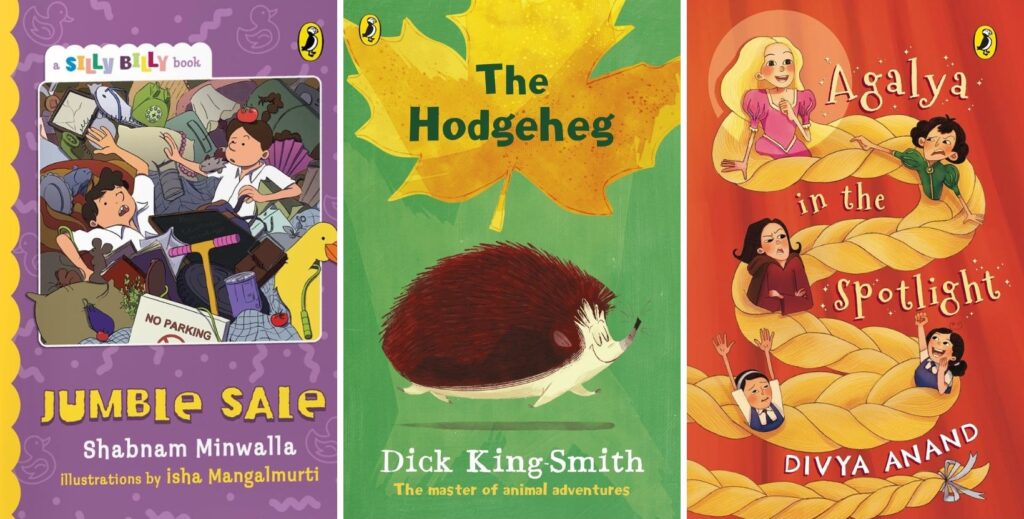
The Bald Bandit
July 5, 2025
Who doesn’t love a good mystery story? I love the A to Z Mysteries because they’re exactly the right level for my book club. The characters are fun, the mysteries are engaging, and the fact that we have a whole series of twenty-six books to read makes The Bald Bandit an easy choice for me. Even though the book is over twenty-five years old, it doesn’t feel dated. I’m sure we’ll have fun with it!

Clues
Fingerprints, shoe prints, bits of fabric–they’re all clues! Let’s have some fun with them. We’ll draw the outline of our foot and try to make it look like a footprint. We’ll play with thumb prints and try to look around us to see what signs we can find of the other people who live at home with us.
Mysteries
A storytelling worksheet is a great way to explore a rough outline of a story. I will give the children the framework of a story and ask them to fill in the details. Let’s see what mysteries we create!
A Detective Club
If you set up a club to solve mysteries, what would your club be called? Who would be part of it? What would your password be and where would you make a secret hideout? I’m looking forward to seeing where my book clubbers’ imaginations will take them!
Join a book club!
Other books in the series that we’ve read at my book club:
Registrations are now closed for the August-September 2025 edition of my book club. New batches begin every alternate month. Join my mailing list if you would like to receive email notifications about my programmes. Alternatively, follow me on social media – Facebook and Instagram – for regular updates.

The Hodgeheg
July 4, 2025
I love Dick King-Smith‘s work. There was a time when I read nothing except his books. I devoured story after story, the way children do when they get hooked on to an author. I remember just one book I didn’t enjoy – Godhanger. But everything else? I loved.
And that’s why we’re rereading The Hodgeheg, one of my favourites! It’s a sweet story about one determined hedgehog who makes it his mission to find out how to cross a road safely. How do humans cross? Can’t a hedgehog do the same? Here’s what we’ll do with this book at my book club.
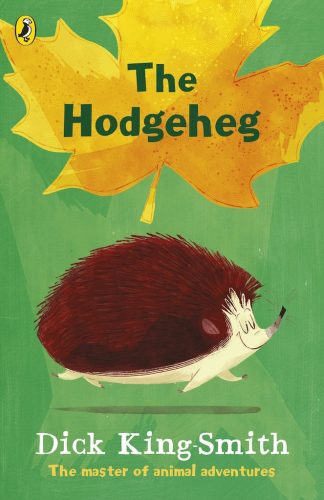
Slang
The Hodgeheg begins with another hedgehog having ‘copped it’. Later on, we have the phrase ‘that’s flat’.
What do these phrases mean? The way in which words and phrases develop regional variations is fascinating. I remember reading the phrase ‘I bet a monkey’ while I was reading Georgette Heyer. I first thought Heyer was just being funny. I looked it up and discovered that a monkey is British slang for five hundred pounds, American slang for five hundred dollars, and Australian slang for – wait for it – a sheep!
We’ll look at a few funny phrases from different parts of the world; I can’t wait to see what we’ll discover!
Unscramble
When the hedgehog Max is hit on the head, his words come out all scrambled, which is what gives the book its name.
Of course, this leads to a simple, fun activity – unscrambling letters to make words, putting words in the right order to create sentences, and putting lines in the right order to create a poem.
Creating Characters
The first thing that sets Max apart is his name. But there’s more to Max than a unique name. What makes a character leap out of the pages?
As my reading programme for ages nine and ten has a strong creative writing component, we will use the text to work on creating memorable characters. If you have a character that your readers will root for, your story is already half done!
Join a programme!
Registrations are now closed for the August-September 2025 edition of Read, Write, Explore. New batches begin every alternate month. Join my mailing list if you would like to receive email notifications about my programmes. Alternatively, follow me on social media – Facebook and Instagram – for regular updates.

The Adventures of Mooli and the Sticker Trickster
July 3, 2025
The very first book we read at my very first online reading programme was Trouble with Magic by Asha Nehemiah. We’ve read several of her books over time, and this time, we’re rereading The Adventures of Mooli and the Sticker Trickster. This isn’t the first of the Mooli series, but it works well as a standalone book!
Mooli and Soups are busy ideating. They must come up with an idea that will win a prize at WAYOUTS – World’s As Yet Original Untried Tricks and Stunts. What can they do that will be simply outstanding? Surely, two intrepid young children can come up with not one, but a hundred ideas!
In the middle of all this, however, they have a mystery to solve. Who could be vandalising Mooli’s Amma’s signboard with silly stickers? Why does her board now read ‘Yummy Scrummy mon Keys’?
A hilarious adventure ensues as Mooli and Soups get to the bottom of the mystery and find the vandal. Characters leap off the pages in this funny page-turner. In the hunt for the thief, maybe, maybe Mooli and Soups can do more than just solve the mystery!
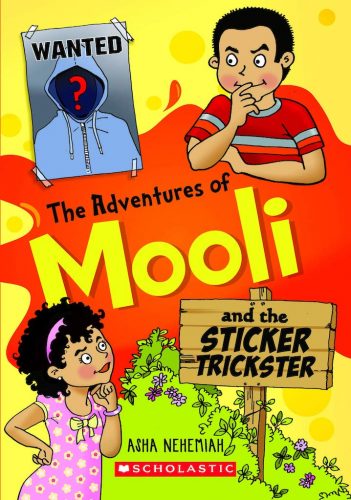
WAYOUTS
I love the idea of WAYOUTS! What thoroughly original idea can you come up with? What can you (safely) do that you think no one has ever done before?
At my book club, we’ll share every idea we can think of – the wackier the better!
Word Collage
The sticker trickster cuts out words and sticks them on Gita Aunty’s signboard.
Equipped with a newspaper and a stick of glue, let’s see what we can do together. We could make a birthday card, a book cover, anything!
Alphabet
Playing with the alphabet is always fun, and no one is too old for it! Mooli and Soups use yogasanas to create the alphabet; what can we do? Quite a lot, actually depending on the amount of time we have.
For one, we could play with the wonky alphabet, in Craig Smith’s style. For another, as I was reading The Adventures of Mooli and the Sticker Trickster, I remembered that as children, we had a sign for each letter of the alphabet – a secret code! I still remember so much of it that I would love to pass it on. Who doesn’t love a good code?
Join my book club!
Other books by Asha Nehemiah that we’ve read at my book clubs:
- The Adventures of Mooli and the Blue-Legged Alien
- The Adventures of Mooli and the Bully on Wheels
- Trouble with Magic
- A Pinch of Magic
- The Mystery of the Secret Hair Oil Formula
- The Mystery of the Silk Umbrella

Jumble Sale
July 2, 2025
Jumble Sale is such a delightful Silly Billy Book that I can’t wait to read it with my book club! Just like Agassi and the Great Cycle Race, which we read recently, it is a hilarious read that promises to cause much laughter as we read it together!
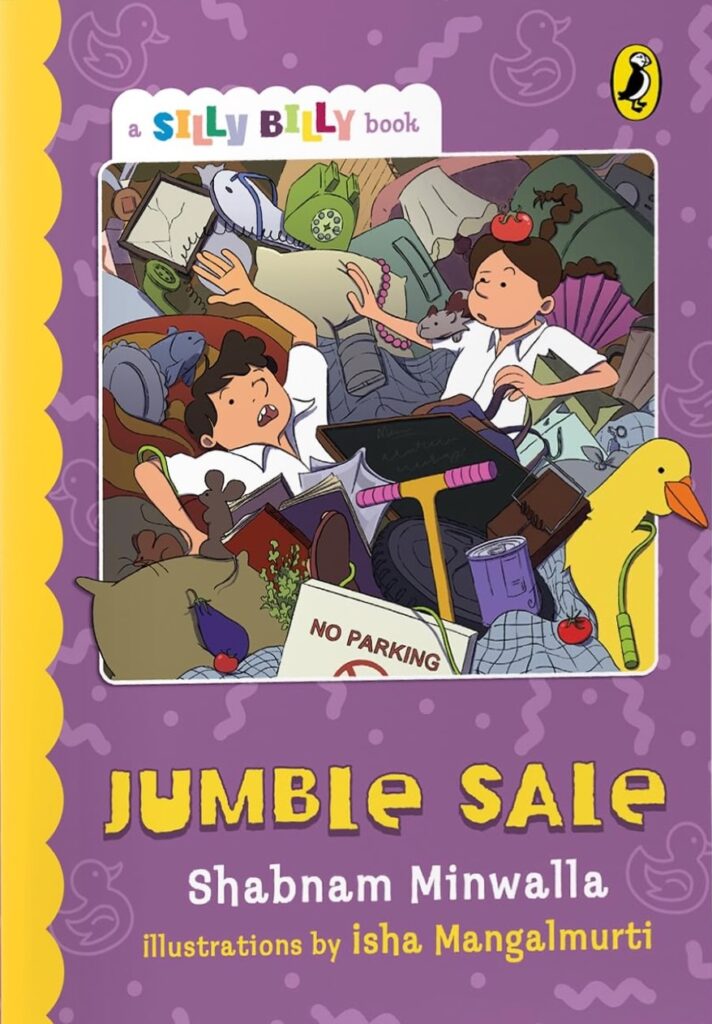
Jumble Sale
If your school organised a jumble sale, what would you sneak into it? What do you think you could sell with no one noticing? And how audacious do you think you could get?
Songs
I can’t think of Jumble Sale without thinking of Tinaz Toddywalla singing, “Just you wait, ‘Enry ‘Iggins, just you wait!” I don’t know how many children at my book club will be familiar with the song, so we’ll listen to it and perhaps make it a listening exercise too!
Mysteries
Is a missing bottlebrush an intriguing enough mystery to solve? Each edition of Read, Write, Explore comprises three creative writing classes, and during one of them, we will explore a silly mystery! What tiny theft could be a mystery worth solving, and how would we go about it?
Join a programme!
Registrations are now closed for the August-September 2025 edition of Read, Write, Explore. New batches begin every alternate month. Join my mailing list if you would like to receive email notifications about my programmes. Alternatively, follow me on social media – Facebook and Instagram – for regular updates.

Vincent Can’t Go
July 1, 2025
Another book that’s hot off the press is coming to my book club! Vincent Can’t Go is a charming story about a boy who isn’t allowed to go anywhere because his mother is too afraid. I enjoyed this sweet, simple story, and I’m sure my book clubbers will too!
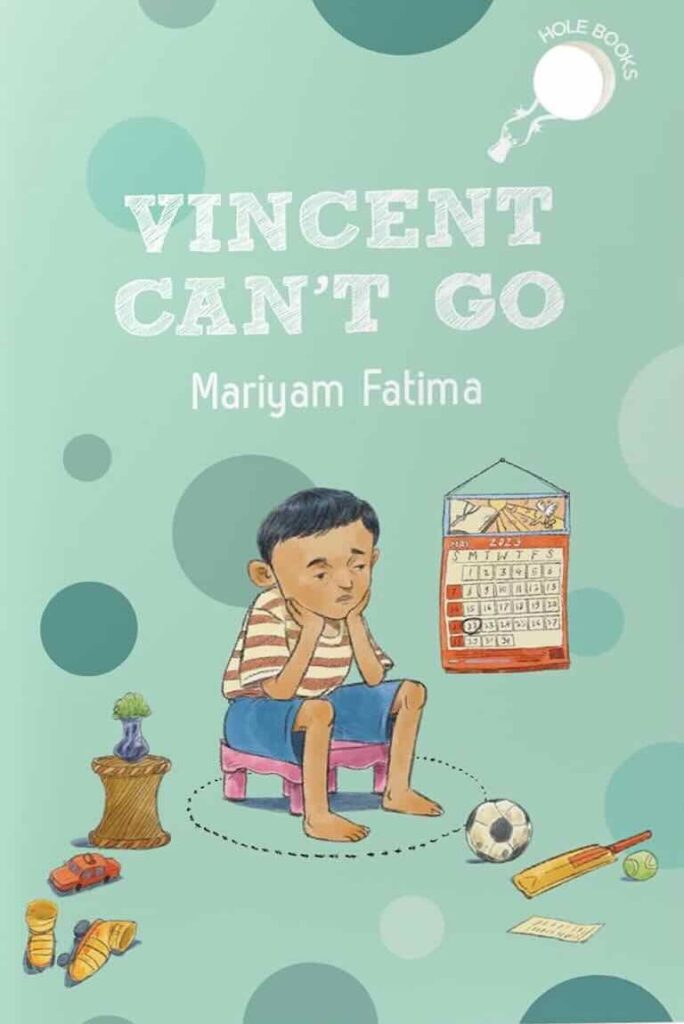
Interactive Game
What are you allowed to do? What are you not allowed to do? Let’s play a game!
After that, we will use an interactive whiteboard to explore new ideas of things we would like to do if we were allowed to do them!
Friends
Friendship is an integral part of Vincent Can’t Go. I’d like for the children at my book club to show me a picture of their friend, what they have in common, why they’re friends, and anything else they would like to share!
Portraits
I love Habib Ali’s pictures of ‘Most Important Friend’ and ‘Man of Action’! In class, I’ll ask the children to draw a self-portrait with an ornate frame and a label of their choice!
Join a book club!
Registrations are now closed for the August-September 2025 edition of my book club. New batches begin every alternate month. Join my mailing list if you would like to receive email notifications about my programmes. Alternatively, follow me on social media – Facebook and Instagram – for regular updates.

The Second Person Short Story
May 31, 2025
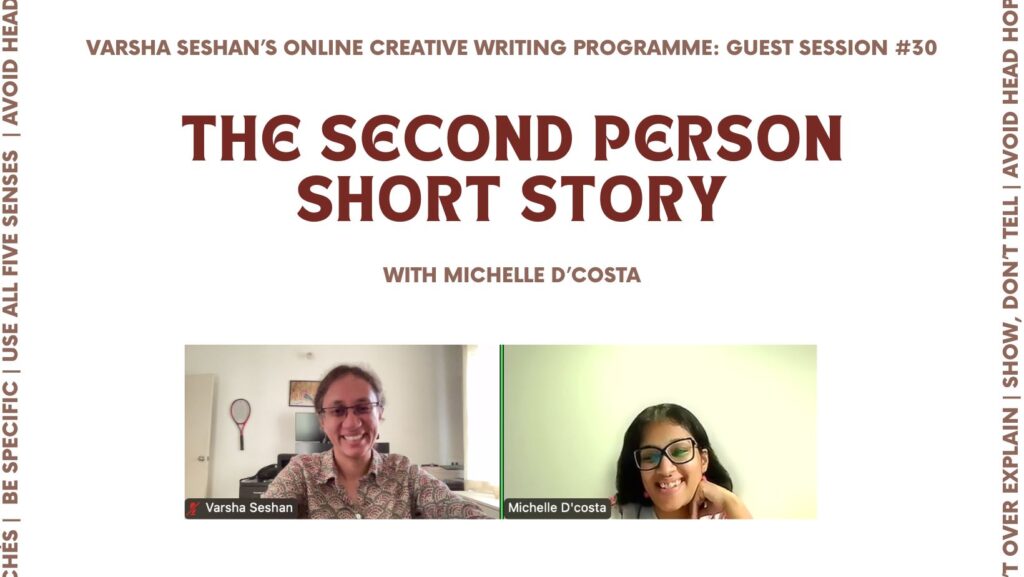
We haven’t ever worked on the second-person short story, which is what made this writing workshop particularly interesting for me! I love it when I get to work with something new at a guest session!
Michelle D’costa conducted a detailed session, introducing the three narrative perspectives and focussing on the second person narrator. From common misconceptions about the second-person narrator to hands-on writing exercises, Michelle covered a lot of ground in the course of one short hour.
We read a mentor text, explored how we can write in second-person, and discussed a few things to keep in mind when we write a short story. I especially like it when guests I invite reinforce ideas I’m teaching! Here are a few things Michelle mentioned, for instance!
- Avoid clichés
- Be as specific as you can, both for setting, and for character
- Use all the five senses–smell, taste, sight, hearing, touch
- Show, don’t tell
- Avoid head-hopping
We worked on paying attention to detail with an oral exercise for which Michelle showed us a picture of a man. Michelle emphasised the importance of describing what is actually visible rather than making assumptions. Show us what we can see; let the reader make assumptions!
With this, our third guest session, we’re now hurtling towards the end of yet another writing programme. How many courses have I conducted? I have now officially lost count. And I love that.
Dum Dum to the Rescue & Yet More Adventures of Little Shambu
May 8, 2025
Did you read Shikari Shambu? I did, and I loved each silly adventure. That’s why we’re reading yet another Little Shambu book at my book club. We read Strangus Derangus in April 2024, In the Bear’s Den in November 2024, and it’s time to read the last one–Dum Dum to the Rescue.
I enjoyed all these stories for their silliness and simplicity, as well as the lovely illustrations. An urban child’s interactions with animals may be few and far between, but there are a range of hilarious stories in store for us in this collection.

Role Play
Any book that is rich in dialogue is perfect for role play. Helping children recognise when characters begin to speak and when they stop, beginning to recognise speech marks and paragraphs … all this is part of a book club!
Animal Encounters
Have you ever had a fun/frightening experience with an animal? A monkey in your neighbourhood? Or a snake in your school? I’d love to know! We will also try to write a small poem about it!
Listening Activity
Bringing the four language skills together is an important part of language acquisition, and there are so many animal stories we can listen to online! Let’s see how much we can understand as we listen to an audio recording of an age-old animal tale.
Join a book club!
Little Shambu is a delightful character, and the themes of this book are perfect for 7- and 8-year-olds!
Registrations are now closed for the June-July 2025 edition of my book club. New batches begin every alternate month. Join my mailing list if you would like to receive email notifications about my programmes. Alternatively, follow me on social media – Facebook and Instagram – for regular updates.
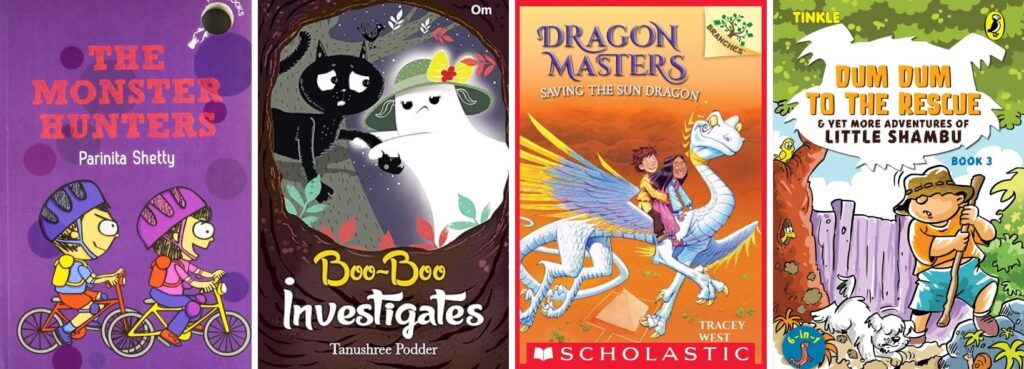
The Mystery of the Missing Geometry Boxes
May 7, 2025
Who doesn’t love a good mystery? When geometry boxes begin to go missing, the AKA Detective Club finally has a new mystery to solve! But things always go missing in schools, don’t they? What’s the big deal? When a pattern begins to emerge, however, the young detectives know that something is fishy. Surely, no one would want more than one geometry box. And is there a reason why only Yuga geometry boxes are being stolen?
The Mystery of the Missing Geometry Boxes is a lighthearted mystery, funny and engaging. I look forward to introducing it to my book club!
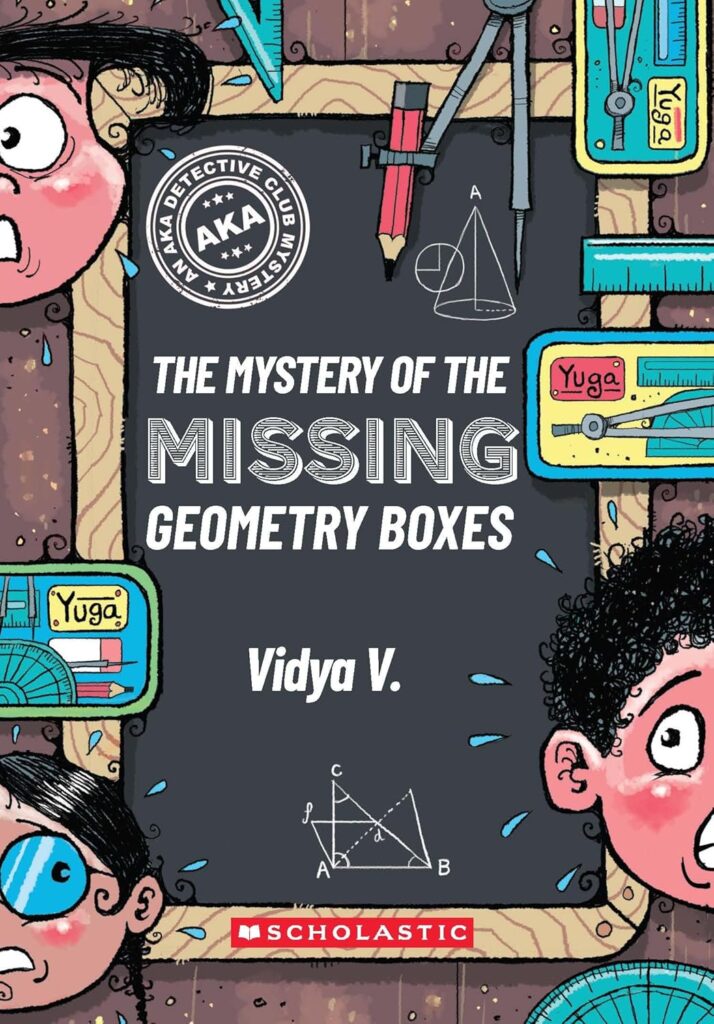
Detective Club
AKA stands for Aarav-Karthik-Asha, or Asha-Karthik-Aarav, depending on whom you ask. What would your detective club be called? Would you have a password and a secret code? Let’s make one together!
Geometry Boxes
I enjoy linking reading with other activities! I’m not yet sure if it will be exciting, but we’ll look at using the tools in our geometry boxes to create art of our own. Let’s see what we can come up with!
School Mystery
Mystery is one of the most satisfying genres to read, and quite an exciting genre to write too! At Read, Write, Explore, one class every two weeks is devoted to creative writing, so once we’ve read The Mystery of the Missing Geometry Boxes, we will attempt to write a mystery story of our own. What mystery could take place in our school? How would we solve it?
Join a programme!
The Mystery of the Missing Geometry Boxes is the second book in a series featuring the AKA Detective Club. The joy of a series is that if children like one book, they’re likely to hunt for and get the others that feature the same characters.
Registrations are now closed for the June-July 2025 edition of Read, Write, Explore. New batches begin every alternate month. Join my mailing list if you would like to receive email notifications about my programmes. Alternatively, follow me on social media – Facebook and Instagram – for regular updates.
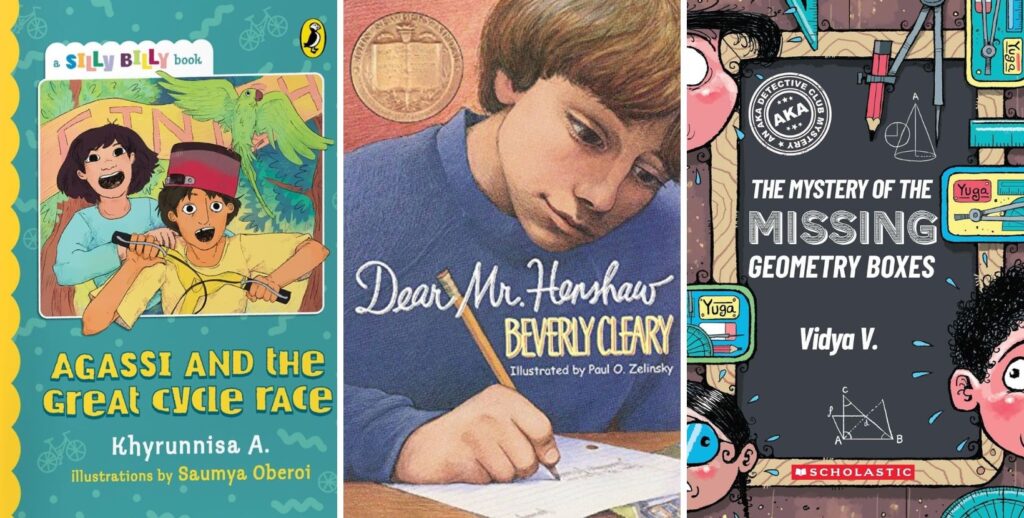
Saving the Sun Dragon
May 6, 2025
We read Rise of the Earth Dragon, the first book in the Dragon Masters series, nearly four years ago! It was another of those books that set children off on a reading journey because there’s a whole series to devour.
That’s why we’re reading Saving the Sun Dragon next month. It’s the perfect reading level; it’s imaginative, features driven characters, and has a good bit of adventure in it!
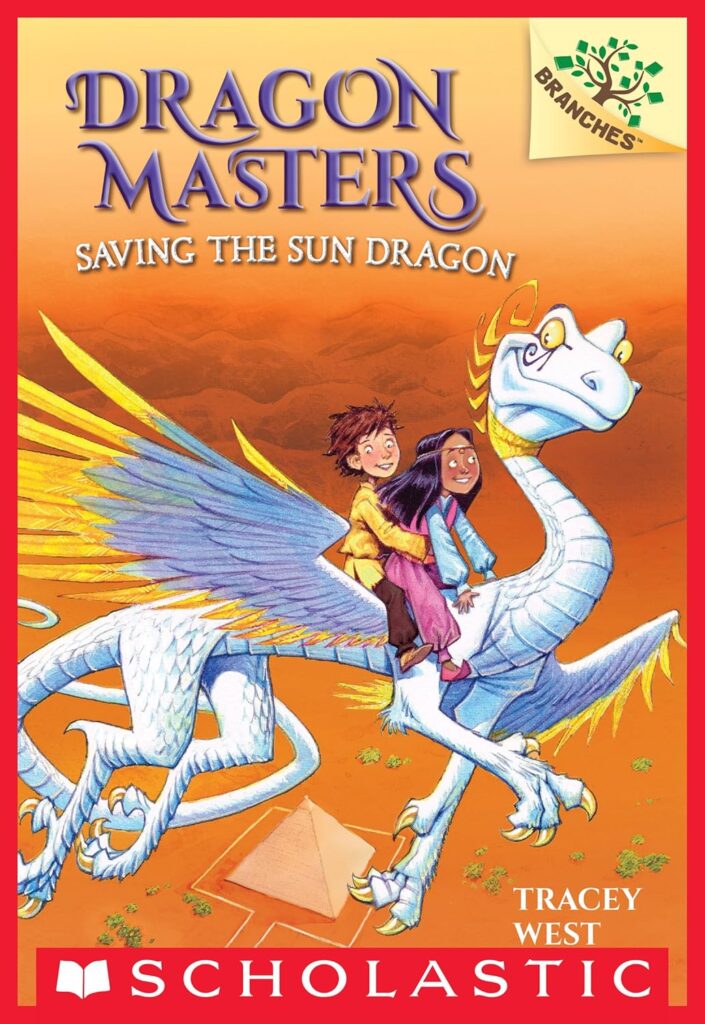
Colouring Pages
I love it when authors share fun activities on their websites! As we read Saving the Sun Dragon, I’ll ask parents to print a few sketches that we will colour together in class!
Create a Dragon
We’ve read about an earth dragon; we’re reading about a sun dragon. What other dragons can we create? What is its name? What powers does it have?
Diary of a Dragon Master
If you were a dragon master, what would one day in your life look like? We’ll explore a few ideas and then get writing!
Join a book club!
Like I’ve said before, reading a series is a great way to get children hooked to reading! The Dragon Masters series is a lovely introduction to fantasy and adventure, and it promises to be a fun book to read together!
Registrations are now closed for the June-July 2025 edition of my book club. New batches begin every alternate month. Join my mailing list if you would like to receive email notifications about my programmes. Alternatively, follow me on social media – Facebook and Instagram – for regular updates.

Dear Mr. Henshaw
May 5, 2025
I’ve said this dozens of times: I love epistolary novels. I made a video about a few favourites for World Post Day 2021, I love doing letter-writing activities at workshops, and I’ve written an epistolary novel of my own.
When we read Dear Mr. Henshaw for the first time at my book club, I knew it would be a book I would introduce time and time again. So come June, we’ll be rereading this delightful book at Read, Write, Explore!
Leigh Botts writes to his favourite author, Boyd Henshaw, and in the beginning, he doesn’t get a reply. Later, he gets a printed response, rather than a handwritten one, which is almost as disappointing. When he is in the sixth grade, however, he receives a proper letter, which he needs for his author report, and this is the beginning of a funny, moving series of letters he writes about himself, his school and family. As we read Leigh’s letters, we get to know not just him but Mr. Henshaw too. I love it!
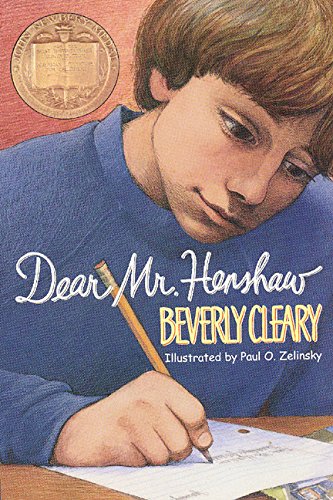
Questions
The questions Leigh asks Mr. Henshaw set the ball rolling, and this will lead us to our first activity with the book. If the children had to write an author report, what questions would they ask? And if they don’t like the responses they receive, what will they do?
Taking this idea further, I would love for the children to write to their favourite writers and see whether they receive replies!
Other Scenarios
Even if the children haven’t read The Diary of a Young Girl, most have heard of Anne Frank. Using Dear Mr. Henshaw, Anne’s diary and a few others, I would love for the children to come up with other scenarios in which a story in the form of letters could work. Why would two characters write to each other? And how would the story progress?
Letters
At Read, Write, Explore, one class every two weeks is devoted to writing. Naturally, as we read Dear Mr. Henshaw, we will write letters. This time, I would love for the children to write real letters to one another and post them too. I’ll guide them through a little letter-writing activity, following which I will encourage them to write whatever they want. Each time I work with letters, I realise that many children have no idea what a stamp is or what purpose a letterbox serves. And that makes the whole process even more fun!
Join a programme!
Registrations are now closed for the June-July 2025 edition of Read, Write, Explore. New batches begin every alternate month. Join my mailing list if you would like to receive email notifications about my programmes. Alternatively, follow me on social media – Facebook and Instagram – for regular updates.

Lights, Camera, Action!
May 4, 2025

Lights, Camera, Action! was a whirlwind introduction to filmmaking, one which I thoroughly enjoyed. I know next to nothing about filmmaking, making this guest session all the more exciting for me. What an informative, detailed session it was!
We began by watching a short film in French, Detour by Michel Gondry. Samina Mishra, our guest for the evening, asked us what we thought of the film and then we revisited a few details from a filmmaker’s eye.
What goes into mise en scène, or the frame of a film? What about cinematography? What does one pay attention to? Sound? Editing? What else?
After looking at a range of elements from setting to costumes, effect sounds to editing, Samina left us with a writing exercise in which she asked us to write a single shot. With clear examples, she asked us to pay attention to the following things as we wrote:
- Will we see the exterior/interior? What time of day is it?
- What kind of shot will it be? A long shot or a close-up?
- How is the scene set?
- What is the camera angle?
- What do we hear?
- Does the camera move or wait until the whole shot is over?
It was unfair to ask Samina to pack it all into an hour, and we did overshoot, but it was a thoroughly enjoyable session nonetheless. Here’s to many more!
